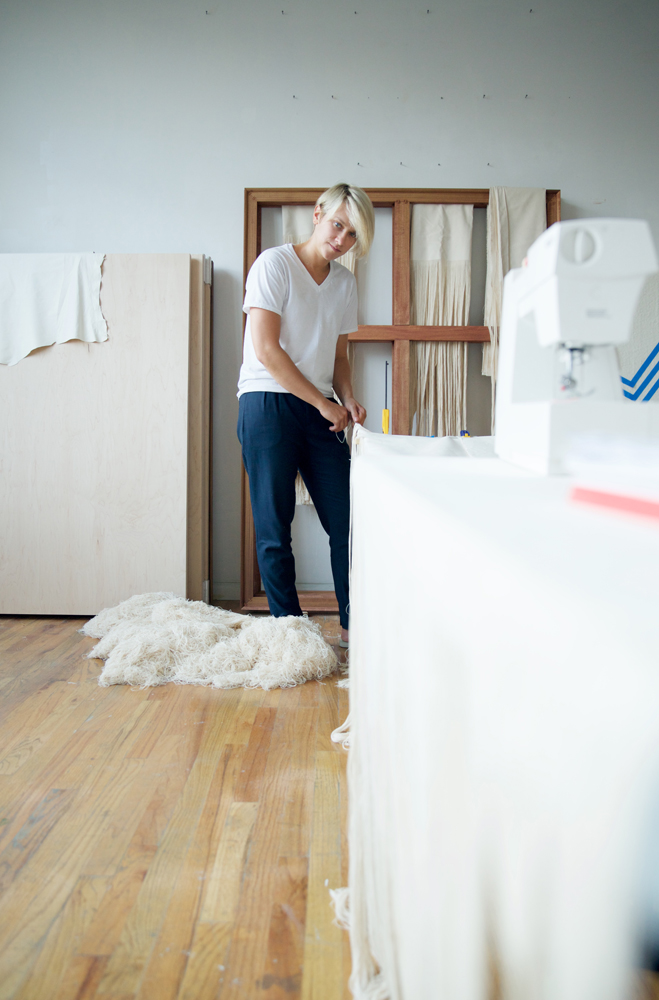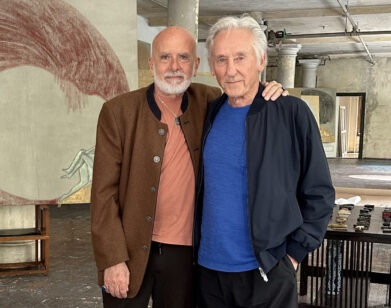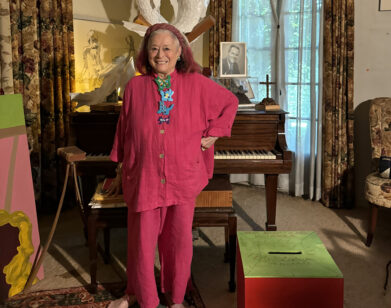Artists at Work: Rebecca Ward
REBECCA WARD IN BROOKLYN, NEW YORK, AUGUST 2015. PHOTOS: FRANK SUN.
This month we’re visiting New York-based artists in their studios, ahead of fall exhibition openings.
Upon Googling Rebecca Ward, the first web result is a sabre fencing Olympian, yet the image tab reveals images of an artist’s intricate, brightly multi-colored, large-scale geometric duct tape installations. Ward, a Brooklyn-based Texan, began these installations as an exploration of material and process during her undergraduate studies. During her years at the School of Visual Arts in New York, where she received her MFA and studied under the likes of Marilyn Minter, however, she underwent a shift toward softer, process-oriented paintings and sculptures. Now, muted canvases often expose the wooden frames on which they are stretched through the material’s deconstruction. Ward de-threads fabrics to focus on each individual string; cuts, sews, and distorts supple lambskin; and splices together thin layers of wood, evoking notions of basket weaving.
“I like the idea of taking a form and cutting it apart and putting it back together,” she tells us in her Bushwick studio. Be it through sculpture, sewing, weaving, or painting, Ward’s processes always point toward feminine associations, something she intentionally infuses within her work to address her role as a progressive feminist.
We first met the Waco-native in April, when she was preparing for a show in Puglia, Italy. She offered us beer (and then whiskey) and homemade cookies. When we returned in August, while she was preparing for her third upcoming solo show at Ronchini Gallery in London, the warm welcome was replicated. We noticed smaller details, like a basketball sitting on a shelf (yes, she plays) and a horseshoe hanging above the door. These details allude to simple hobbies and perhaps superstitions, but others reveal her dedication to craft and language. She has a sewing machine setup with strands of de-threaded material falling by its side, and a bookshelf in the corner that is overflowing with Roland Barthes—after all, her artist statement is simply a scan of the philosopher and semiotician’s “Soap-powders and Detergents.”
EMILY MCDERMOTT: Can you tell me about what you are working on for the show at Ronchini?
REBECCA WARD: I think I’m going to make probably nine paintings for the show. I’m doing regular format ones and I’m also going to do some in the shape of triangles. I’m also hoping to get some marble works fabricated and then some of the wooden sculptures I started doing. It’s actually going to be less painting-heavy and more sculpture-centric, so those and the string pieces. [The string pieces] are a pretty slow process but I like it. It’s meditative and a good transition into the other parts of the work.
MCDERMOTT: I remember you saying that you enjoy monotonous tasks.
WARD: [laughs] Yeah, I guess it’s the obsessive-compulsive side of my brain.
MCDERMOTT: Within your studio right now, there’s canvas, leather, string, wood, and other fabrics. How do you decide what material you want to work with for each project?
WARD: I’ve been exploring fabric for a while. I was using more patterned fabric for some time and that led me into using silk. Then I started thinking about very luxurious textiles and that led me to leather. They are expensive and luxurious for a reason. There is something extremely seductive about them, but also I like leather because when it’s stretched you almost don’t even notice it’s leather; it almost looks like canvas. It’s a nice surprise for that to happen on top of the painting that’s going on. Then there’s batting, which is a fabric that’s used in quilting.
Batting was a fun choice because it relates back to quilting but it’s not a quilt. It’s able to talk about that idea but not so directly. The result, when I’m done, it’ll be a little bit fuzzier. When you pull tape off, it leaves this really fuzzy area; it looks like a loveable object. I think that relates back to texture and those things I’m interested in.
MCDERMOTT: Why do you use the outline of letters on certain works, like these batting ones?
WARD: I was already working with architecture in a big way, and I’m interested in language and words. Breaking down the architecture of a letter is a good way to approach that territory without thinking about something more concrete. Titling a work something specific is much different than putting it on the canvas or the frame. It’s a way of abstracting.
MCDERMOTT: So is there a specific meaning behind each letter?
WARD: Yeah, there is—it’s actually a very personal question. They are first initials from people who have been quite meaningful to me. As a result, the titles become very personal.
MCDERMOTT: So in general, how you do come up with titles? I know they’re very important to you.
WARD: I think there are several aspects. They partly are biographical, and some of them less explicitly so. My parents were both social workers, so I was forced to talk about my emotions a lot as a child. I hated that, but now if I think back on it, I see that I have this really rich vocabulary and understanding of my emotional stages and I’m very sensitive to other people’s, so a lot of the words encompass these very complex psychological states, which is also the power of a word, it’s the ability for one word to say so much in a succinct way. If I title a piece “Ambivalence,” a viewer might not have that specific emotional reaction to the piece, but I think it’s an important thing to talk about in correlation with the work.
MCDERMOTT: When you have an idea, what is the process like for its articulation? How do you decide where you are going in terms of sculpture or painting?
WARD: My background is more in sculpture and installation. I was making these tape installations for 10 years and I think work ultimately reaches a point where you are just done with it and you don’t want to do it anymore—that’s what happened to those pieces, but then they gradually found this new form and new life, and that was through the wood I started working with. Maybe that’s a bigger metaphor for something can only end when it finds some other form.
So the wood works evolved from the tape installations, but I don’t think I would’ve been able to make the leap directly if I hadn’t been into paintings. I started thinking more about frames when I worked with the paintings and how the image that’s on the painting responds to the frame. Now I’m working more with shaped frames, and naturally, it makes sense to have these wooden architectural sculptures that relate to that. It’s a slow process that happens over years and years of time.
MCDERMOTT: How did you become interested the exploration of materials and process?
WARD: I had a really influential professor in undergrad. It was when I first started working with tape and she encouraged me to order a box of the material without knowing where I was going to go with it. I think that initiated in me a process-oriented type of art making, because the pressure of knowing the end result became less overt. That was a really important moment for me, when I realized that you didn’t have to know exactly what something was going to look like before you started. I think now I have a pretty clear image of what will happen before I start the piece, but if I didn’t have that sensibility I wouldn’t have been able to arrive at these ideas.
MCDERMOTT: What about your interest in language? Where does that stem from?
WARD: I love to read and more recently I’ve been reading more poetry. I also am a big fan of [Roland] Barthes, who I understand and don’t understand a lot of times. I think he touches a lot on the idea of the abstraction of language, and that’s such rich territory. I went to the Nancy Princenthal reading of her new Agnes Martin book two Mondays ago and she touched on that concept too. For someone working in the territory of abstraction, it kind of mirrors the same idea in language that words have such rich meanings, that their power is so much more than a singular definition. I think it’s the same with materials. That’s why I love post-structuralism; it’s breaking things down to their central forms.
MCDERMOTT: When did you first come across Agnes Martin? I know she’s a huge influence for you.
WARD: I can’t remember the first time I ever saw her work, but I really remember the first time she struck a chord with me was when I saw her painting “The River” at the Whitney. I think I was struck by the fact that it felt minimalist but there were these tiny lines that you didn’t see until you got up close, and once you did they were practically pink. I thought that was so tender and specific—for a large format grid to be rendered pink. But then I didn’t think about it again until a couple years later.
I’ve been keeping her in my mind significantly for the past couple of years. There are so many artists that are my age, younger, older who are inspired by her, and rightly so, because she was such a sage—she spoke of her work and her practice in a way that was so much bigger than just what the work was about. It was the way she lived and the way she constructed her studio practice. I think the way she constructed the dialog around her integrated fully with her life.
MCDERMOTT: Then going back to childhood, when did you first become interested in art in general?
WARD: I always liked it. I always wanted to pursue creative things. It’s a very typical experience—when you’re in sixth grade you have to choose between art and band, I chose art. My parents were very skeptical that I was going to be a very bad artist, and I’m glad I didn’t listen to them, but I stopped doing it for a while because I got very upset with one my art teachers in seventh grade. She would hold these political debates in class, because of the elections at the time, and everyone at my school was a Republican, and I was team Clinton. I was very dismayed; it was a very strange experience for a seventh grader. I had the sense that art was becoming more like work; I wasn’t getting as much pleasure out of it as I wanted. I think she killed that sensibility in me.
MCDERMOTT: When did you become comfortable referring to yourself as a feminist? Growing up in Texas, as you mentioned even with the Republican/Democratic thing, I feel like it would have been hard.
WARD: I had such amazing parents that that wasn’t ever difficult. I never had a problem standing up to my classmates who may have had a problem with it. I may have almost been naïve about it. I remember a conversation in third grade with my teacher about race—who knows what she actually thought or what her political stance was, but I never shied away from those discussions because of where I was. I would love to go back there now; it’s almost like I see it more clearly and I would be more afraid or disheartened having those conversations with people. I don’t know how I was so emboldened as a kid. I think I was maybe born a feminist.
MCDERMOTT: Now you employ techniques traditionally associated with women, like sewing and the idea of quilting, but you do it in a way that’s not necessarily overtly feminine. How do you feel about that and your role as a feminist?
WARD: Certainly that was an intentional move, to start incorporating sewing into the work, because I think it relates to the history of craft, which is really women in all cultures, not just American culture, and it changes the dialog around the work, and of course I’m interested in that. It becomes difficult to talk about gender because that’s where words become a problem. You can use the word female, but I don’t think it’s the best way to talk about it. I think that’s what you’re pointing out, maybe. I’m trying to find the words… I was thinking about the minimalists and works that are, for the most part, fabricated and industrial and steel. I wanted to find a counter balance to those types of works, and be able to speak to those forms, but I think that craft or these processes that reference femaleness are a stark difference.
MCDERMOTT: It’s much softer.
WARD: It is. It’s calmer, too. I think that’s an important dialog to bring in to this type of work that’s so historied. I love that area of ambiguity and androgyny, almost. But for the most part, if we’re gonna talk in gender, they come across as very female. [laughs]
MCDERMOTT: I wanted to ask if you listen to music or anything else while you work?
WARD: Sometimes I listen to books while I’m working. I just listened to Between the World and Me by Coates. He reads the book, so it’s really nice. For music, I love country music, being from Texas. Actually, one of my best friends is a producer in the music industry. Instead of listening to the stuff I listened to 10 years ago, she keeps me up to date. I’ve also been listening to Sturgill Simpson for three or four months. His lyrics are so fucking good. I’m obsessed. He’s playing in New York. I’m gonna try to go see him. I went to Willie Nelson last night [at] Prospect Park at the bandshell. I think he was really stoned when he came out on the stage.
MCDERMOTT: We did a story on him for one of our print issues and one photo was just him rolling a massive joint.
WARD: I love him. My grandmother actually grew up in the same town as him. That’s my claim to fame. [laughs] I’m gonna say she knew him, but I think they were more just acquaintances. The town was like 50 people, but I’m sure my grandma was a big prude and Willie Nelson was doing drugs behind the school. I think he’s such an interesting artist because he has this populous appeal to him but it doesn’t take away from his amazingness. It’s interesting how he crosses all of these genres of people who love him.
MCDERMOTT: One last question: what are some things you absolutely couldn’t live without in your studio?
WARD: I definitely need coffee all the time. I drink probably four or five cups a day. But I read an article recently on how that’s healthy, so… [laughs] I usually keep a bottle of whiskey in here, too. I’m not a big drinker, but I feel like it’s important to have. I can’t live without scissors. I don’t have any tattoos, but I thought if I ever got a tattoo, it should probably be scissors.
FOR MORE ON REBECCA WARD, VISIT HER WEBSITE.







